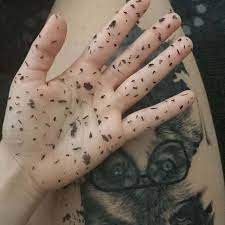
As is typical with tattoo healing processes, your black tattoo may turn grey as it heals. This happens because the open wound created by the tattoo acts like an open sore that needs your body’s natural defenses to repair. The tattoo may ooze, scab, crack, or peel during the healing process. Using lotion won’t prevent peeling, but it can make the process more comfortable. Just make sure to avoid aftercare products with perfumes or alcohol.
During the Peeling Stage
If you have a black tattoo, peeling during the healing process is normal. Peeling usually starts a few days after getting the tattoo and helps remove dead cells so that new ones can grow. Avoid exposing the tattoo to sunlight, as it can speed up the peeling process and worsen it. Also, refrain from scratching the peeling skin, as it can cause further damage and remove scabs prematurely, potentially leaving empty spots where ink was present on the tattoo.
Peeling typically lasts about two weeks and appears white and flaky. The amount of peeling depends on factors such as the location and size of the tattoo, as well as your skin type and tattoo care.
After the Peeling Stage
Tattoos generally heal quickly. They usually appear peeling, flaky, and even oozing during the healing process, which should stop after two or three weeks. If peeling, bleeding, or itching persists beyond this timeframe, consult your tattoo artist or doctor for proper diagnosis and treatment.
If your tattoo looks dull after peeling, using a moisturizer that brightens colors can help them appear vibrant again. Drinking plenty of water can also promote healthy skin and faster healing. Avoid picking at the scabs, which can cause further damage and infection. Let nature take its course for optimal results.
Greying of the Ink
Tattoos naturally fade with age, which should not be considered dangerous or unhealthy. However, if the ink turns grey faster than expected, begins oozing, or has an unusual discharge, seek medical help immediately. Tattoos done by inexperienced artists may also turn grey over time, but touch-ups can often correct this. Avoid picking at greying skin or removing scabs prematurely to prevent uneven healing. Follow the aftercare instructions provided by your tattoo artist and keep the area clean and moisturized to aid recovery.
Itching
Itching is a normal part of the tattoo healing process. It usually starts within a few days after getting a tattoo and may continue for some time. Scratching can damage the skin and result in scarring, so it’s essential to avoid scratching the tattoo.
Keep your new tattoo moisturized with non-comedogenic products to speed healing and reduce itching. Avoid oil-based products as much as possible. If itching persists, consult a dermatologist or primary care doctor immediately, as it could be a sign of infection or other underlying skin conditions like psoriasis. Proper diagnosis will lead to appropriate treatment, such as prescribed ointments or creams for psoriasis.

